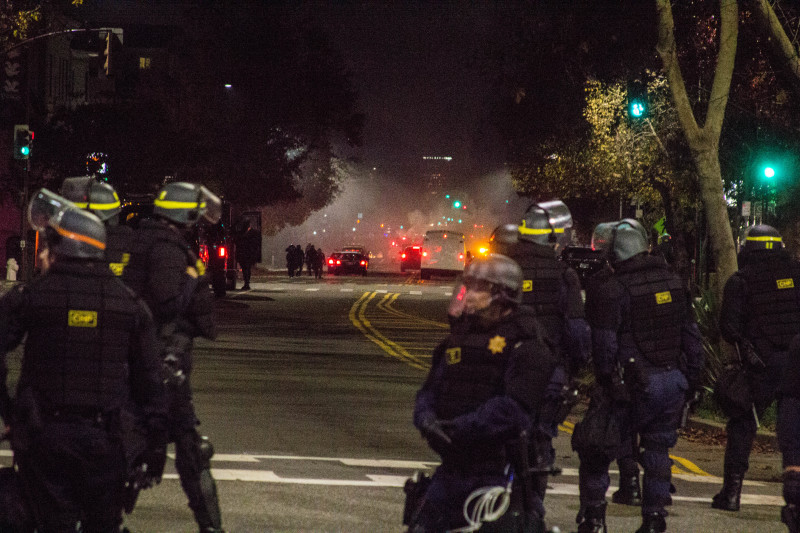George Perezvelez, acting chair of the Berkeley Police Review Commission, said he and other panel members will ask Meehan about the directive, first reported Monday in The Daily Californian.
“It’s an unfortunate use of words. If the intent was, as the quote is, to 'get them running,' that is not the proper way to handle any demonstration in the city of Berkeley,” Perezvelez said Tuesday.
He said a better approach would have been to "keep [protesters] moving, keep them safe, keep them on the streets, make sure they’re safe, make sure the demonstration keeps moving through the city. ... The usage of the words ‘get them running’ gives a much different perspective and definition to the action, and is extremely unfortunate.”
Berkeley police spokeswoman Jenn Coats wrote in an email Thursday that the "get'um running" statement from notes delivered to officers at a pre-event briefing was a "talking point."
"It references helping spread out those groups to be able to better identify specific individuals that were committing crimes," she wrote.
The department posted its own report on the December unrest on Tuesday. The document's conclusion says, in part:
The commanders and officers attempted to do their best to stem the violence and lawlessness that arose during the protests and were not fully satisfied with the outcome. We have no way of knowing what would have happened had the Department applied different strategies and tactics. The Department did many things right over the course of the protests and riots. Through this process we identified many opportunities for improvement. Leaders in the department were instrumental in this process by offering candid critiques, feedback and recommendations. This review's recommendations will serve to positively impact similar future operations.
Meehan has praised officers' "professionalism, patience and courage" in the face of what he characterized as an attack on police headquarters on the first night of the protests -- Dec. 6, 2014 -- and in responding to widespread vandalism the following night. Protest organizers criticized police for what they called an aggressive response that included batons, tear gas and the use of “less-lethal” munitions such as rubber bullets or beanbags.
The protests were called in response to police violence in Ferguson, Missouri, New York City and elsewhere.
The Daily Cal, UC Berkeley's independent, student-run paper, obtained the department documents from the Police Review Commission.
In "briefing notes" presented to department members in the hours before the first evening of protest, officers were advised that in handling demonstrators they should aim to, "Get'um running! Stretch the crowd out so they are not a mass, but individuals."
At the same time, officers were advised, "Hardcore agitators will split up and cause multiple problems. Rapid response to these individuals is critical."
In the event, what had been a vocal but peaceful protest turned into something of a melee once marchers arrived at Berkeley's Public Safety Building, where police were massed. Police accounts -- backed up by a video included in the Berkeley police report -- say bricks and other objects were thrown, and officers responded in short order with tear gas. That set off a long evening of confrontation, complete with repeated volleys of smoke canisters, tear gas and "less-lethal" munitions fired as police moved a crowd of several hundred people south along Telegraph Avenue toward Oakland.
The Daily Cal's story discloses that Berkeley police came close to exhausting their supply of gas and crowd-control munitions the first night of the protests. The paper published an email from Berkeley police Lt. Dave Frankel requesting supplies of tear gas and less-lethal rounds from nearby law enforcement agencies.
Frankel specifically asked for any "40 mm less lethal rounds, 40 mm CS gas rounds, and hand deployable CS grenades." The term "CS" refers to the active chemical ingredient in tear gas.
KQED asked the department how many "less-lethal" rounds, gas rounds and grenades were used on Dec. 6.
Berkeley PD spokeswoman Jenn Coats wrote the department's best guess is "several dozen."
"We don’t have an exact number," she wrote. "One of the recommendations in the report is for better inventory keeping. This was recognized during the protests and changes were implemented."
Berkeleyside got a somewhat more refined number from Wednesday night's Police Review Commission meeting.
